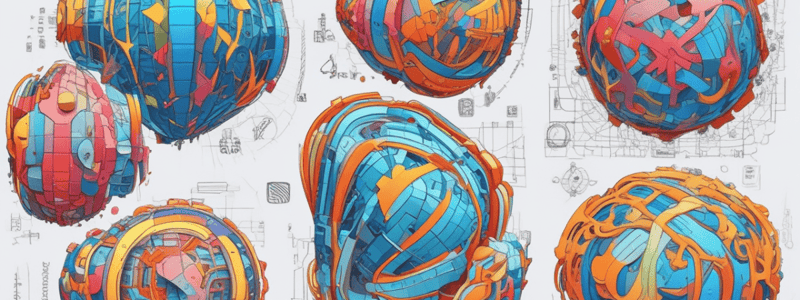Podcast
Questions and Answers
What is the fundamental concept in vector analysis that enables the dissection of complex vectors into simpler parts?
What is the fundamental concept in vector analysis that enables the dissection of complex vectors into simpler parts?
- Applying trigonometric identities to ascertain the magnitudes of vector components
- Combining multiple vectors to yield a single resultant vector
- Deconstructing a single vector into constituent components
- Resolving vectors into components (correct)
What is the relationship between the components of a vector and the original vector?
What is the relationship between the components of a vector and the original vector?
- The components are added together to form the original vector (correct)
- The components are multiplied together to yield the original vector
- The components are subtracted from the original vector to yield a new vector
- The components are independent and unrelated to the original vector
What is the typical orientation of the axes used to resolve vectors into components?
What is the typical orientation of the axes used to resolve vectors into components?
- Orthogonal axes, often horizontal and vertical (correct)
- Diagonal axes
- Polar axes
- Arbitrary axes determined by the problem-solving scenario
How are the magnitudes of the horizontal and vertical components of a vector determined using trigonometric functions?
How are the magnitudes of the horizontal and vertical components of a vector determined using trigonometric functions?
In the worked example, what is the magnitude of the horizontal component of the 250 N force acting at a 30-degree angle to the positive x-axis?
In the worked example, what is the magnitude of the horizontal component of the 250 N force acting at a 30-degree angle to the positive x-axis?
What is the purpose of resolving vectors into components?
What is the purpose of resolving vectors into components?
What is the relationship between the components of a vector and the formation of right-angled triangles?
What is the relationship between the components of a vector and the formation of right-angled triangles?
What is the purpose of applying trigonometric identities in the context of resolving vectors into components?
What is the purpose of applying trigonometric identities in the context of resolving vectors into components?
In the worked example, what is the magnitude of the vertical component of the 250 N force acting at a 30-degree angle to the positive x-axis?
In the worked example, what is the magnitude of the vertical component of the 250 N force acting at a 30-degree angle to the positive x-axis?
What is the significance of resolving vectors into components in problem-solving scenarios?
What is the significance of resolving vectors into components in problem-solving scenarios?
What is the magnitude of the x-component of the force 12.5 N at an angle of 230 degrees to the positive x-axis?
What is the magnitude of the x-component of the force 12.5 N at an angle of 230 degrees to the positive x-axis?
Why is it important to decompose vectors into components in vector analysis?
Why is it important to decompose vectors into components in vector analysis?
What is the significance of utilizing the full angle when resolving vectors into components?
What is the significance of utilizing the full angle when resolving vectors into components?
In vector addition using components, what do the x-components of original vectors contribute to?
In vector addition using components, what do the x-components of original vectors contribute to?
What is a systematic step involved in vector addition using components?
What is a systematic step involved in vector addition using components?
How does resolving vectors into components aid in solving complex vector problems?
How does resolving vectors into components aid in solving complex vector problems?
How are multiple forces acting at different angles analyzed using component analysis?
How are multiple forces acting at different angles analyzed using component analysis?
Why is vector addition using components considered versatile?
Why is vector addition using components considered versatile?




